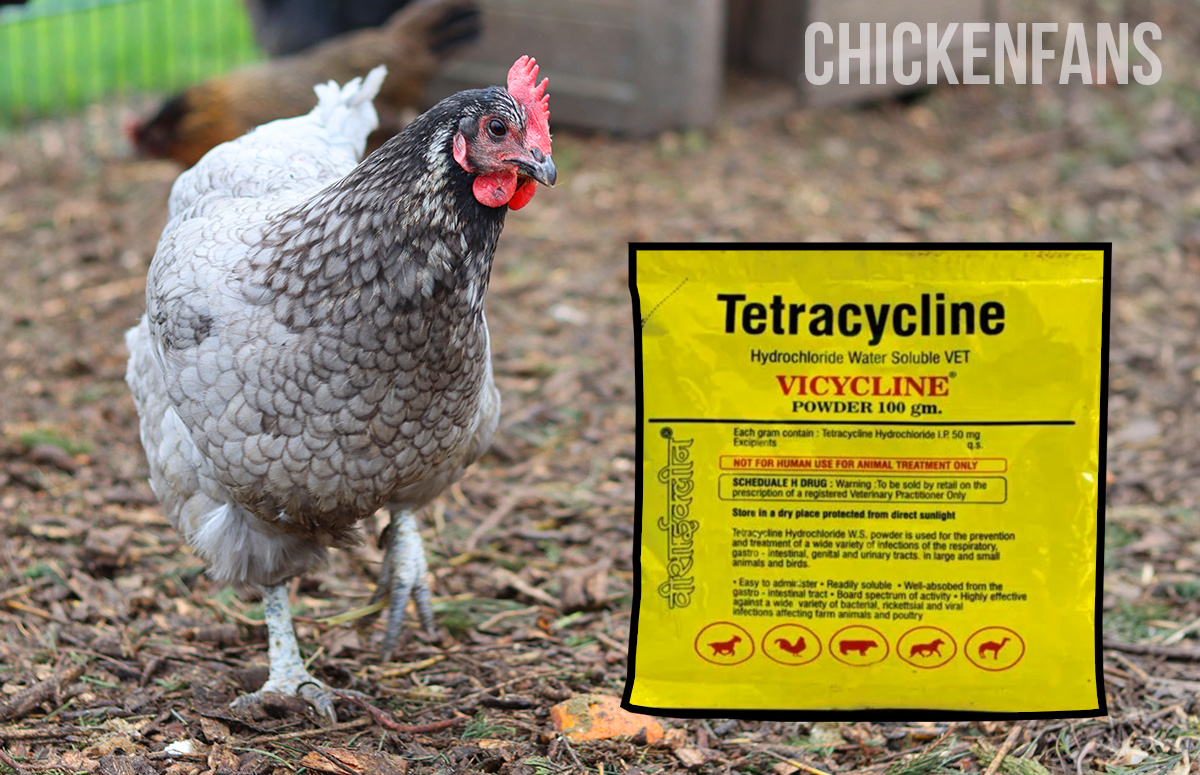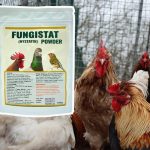Tetracycline for Chickens: Use, Dosage, Egg Withdrawal


Chicken Fans is reader-supported. When you buy through our links, we may earn a commission. Learn more about our privacy policy and disclaimer.
If you’re a backyard chicken keeper, you’ve probably heard of tetracycline, a popular antibiotic. Let’s demystify tetracycline, explaining its benefits, how it works, the dosage, and when it’s best used.
Whether you’re dealing with respiratory issues or trying to prevent diseases in your flock, understanding tetracycline can be a game-changer for maintaining your chickens’ health.
What is Tetracycline?
Tetracycline (brand names: Tetra, Novo-Tetra, Nu-Tetra) is a broad-spectrum bacteriostatic drug belonging to the tetracyclines class of antibiotics. Other members of the tetracyclines group of medications include chlortetracycline, oxytetracycline, and doxycycline.
Tetracycline works by penetrating the bacterial cell wall and inhibiting protein synthesis which impairs bacterial growth.
Tetracycline is efficient against many gram-positive and gram-negative bacteria, like Escherichia coli, Mycoplasma gallisepticum, Chlamydia psittaci, Staphylococcus spp., Streptococcus spp., Pasteurella spp., Salmonella spp., and Klebsiella spp.

When to Use Tetracycline for Chickens?
As a broad-spectrum antibiotic, tetracycline is used to treat several conditions in chickens. Here is a more detailed review of the tetracycline for chicken uses.
Tetracycline for Chronic Respiratory Disease (CRD)
Chronic Respiratory Disease or CRD is an upper respiratory tract infection in chickens caused by the bacterium Mycoplasma gallisepticum.
The infection causes eye discharge, conjunctivitis, gurgling sounds when breathing, gaping, coughing, sneezing, nasal discharge, facial swelling, and head shaking.

The symptoms are more severe in young chicks less than four months old and in roosters.
Tetracycline for Air Sac Infections
Air Sac Infections or airsacculitis is an inflammation of one or more of the air sacs (chickens have nine air sacs).
The condition is also known as Air Sac Syndrome and Air Sac Cold and is typically caused by Escherichia coli and Mycoplasma gallisepticum.
Airsacculitis in chickens manifests with depression, difficulty breathing, open mouth breathing, coughing, tail bobbing, and low exercise tolerance.
Tetracycline for Infectious Synovitis
Infectious Synovitis (known as MS Infection or Enlarged Hock Disease) is an acute to chronic bacterial disease in chickens caused by Mycoplasma synoviae.
The infection is usually subclinical and does not become apparent until a stressful event triggers a systemic disease. Swollen, red, and warm hock joints are telltale signs of infectious synovitis.
The changes in the synovial membrane of the joints and tendons are painful and the chickens have trouble walking.
Tetracycline for Fowl Cholera
Fowl Cholera (known as Avian Pasteurellosis and Avian Hemorrhagic Septicemia) is a highly contagious disease caused by the bacterium Pasteurella multocida. It develops in acute and chronic form.

The acute form is deadly and manifests with fever, ruffled feathers, anorexia, and lethargy. The chronic form is either asymptomatic or causes lameness, torticollis, and swollen wattles.
Egg and Meat Withdrawal Period
You cannot eat eggs or meat from chickens treated with tetracycline. It is not recommended for use in laying hens, and consumption is restricted for at least five days after discontinuing the medication to ensure the absence of drug residues in the poultry products.
In short, the withdrawal period for eggs and meat from chickens treated with tetracycline is at least five days after discontinuing the medication.
Pros and Cons of Using Tetracycline on Chickens
Tetracycline has a broad spectrum of antimicrobial activity, but many organisms are developing resistance to the antibiotic.
Here is a more detailed review of the pros and cons of tetracycline for chickens.
Pros:
- Works against many bacteria
- Fast absorption and effect
- Readily available
- Easy-to-use formulations
Cons:
- Not suitable for laying hens
- Causes greenish-yellow eggshell discoloration
- Some bacteria are growing resistance

Usage and Dosage for Tetracycline for Chickens
Tetracycline for chickens is always used orally and can be safely added to the drinking water or feed. Given in the form of an intramuscular injection, the absorption of tetracycline is slow, and this administration method is not used.
The recommended tetracycline dose for chickens is 50 milligrams per kilogram every 8 hours. When mixing tetracycline with the flock’s drinking water the dosage is between 40 and 200 milligrams per liter and when adding the antibiotic to the feed the suggested dose varies from 100 to 600 milligrams per kilogram feed.
Tetracycline for Chickens Drug Interactions
Tetracycline, like all medications, interacts with certain drugs, making its effects less or more efficient. For example, tetracycline must not be used simultaneously as antacids and certain minerals, like calcium, magnesium, iron, or sodium.
When used together, tetracycline binds with the minerals and forms complexes that are hard or impossible to absorb.
Tetracycline also interacts with another antibiotic called tylosin. Used in combination, they boost each other and show a stronger effect against the bacteria Pasteurella.
Always consult your trusted veterinarian before giving your chickens tetracycline, especially if you are already using certain medications or supplements.
Tetracycline for Chickens Storage and Stability
Proper tetracycline storage is essential for keeping the medication stable, safe, and effective for your chickens.
The oral tablets and capsules should be kept in light-resistant and tight containers at room temperature (between 15 and 30°C).
The oral suspension is stored at room temperature, too, and must not be frozen. For more detailed specifics, check the manufacturer’s instructions.
Conclusion: Tetracycline for Chickens
Tetracycline is a broad-spectrum antibiotic from the tetracyclines class. It is among the most commonly used bacteriostatic agents in poultry and works against both gram-positive and gram-negative bacteria.
Tetracycline for chickens is used to treat many conditions such as chronic respiratory disease (CRD), air sac infections, infectious synovitis, and fowl cholera.
Always talk to the veterinarian before giving your chickens tetracycline to ensure an effective and safe administration. Unregulated overuse of antibiotics leads to resistance.
Frequently Asked Questions
No, you cannot eat eggs or meat from chickens treated with tetracycline. Tetracycline is not recommended for use in laying hens, and chickens treated with tetracycline must not be slaughtered for at least five days after the medication is discontinued.
Given orally, tetracycline for chickens works fast. Depending on the underlying conditions, you should see an improvement in the chickens’ condition within a day or two. The injectable form of tetracycline is poorly absorbed, slow-working, and not used in chickens.

Dr. I. Crnec is a licensed veterinarian with several years of experience. She has published work on the effect of vitamin supplementation, egg-laying performances of chickens under heat-stress conditions and the effects of calcium supplementation on eggshell strength.





















